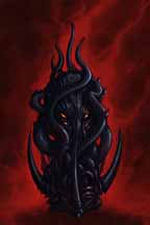|
|
 |
As a general rule, the monstrous creations of H.P. Lovecraft are better read about than seen. When the power of suggestion mingles with the reader’s imagination coupled with a dark room and red wine, the shadowed, slimy horrors of his Cthulhu Cycle take on an overwhelming sense of dread and terror. When his squid-like elder gods and shuffling abominations are either illustrated or brought to life in film, the best they can usually hope for is to inspire a craving for sushi. That said, in departing somewhat from the style of the early 20th century fantasist’s work, Boom! Studios’ Fall Of Cthulhu manages, if not to recreate the subtle mystery and horror of Lovecraft, then at least to adapt some of its mystique to a different medium.
The story starts of with a bang, literally, as a young couple witness a bizarre suicide. By throwing us into the action immediately, writer Michael Alan Nelson sets a quick pace for the first issue, at odds with Lovecraft’s usual slow burn, but he abandons a bit of character development in the process. This is not unusual for the genre, as character exposition is sacrificed nearly as often as virgins and common sense in tales of the fantastic. It’s a trade off that has its advantages as well as its problems. It’s important to get a horror comic moving to pique the reader’s interest, but it’s equally important to create characters that we care about, and Nelson’s characters have yet to really click. Still, as Cy, the book’s protagonist, begins to investigate the suicide of his Uncle Walt, there’s a pervading sense of dread that begins to build, serving as an effective enough hook. And it leads directly to a bizarre dream sequence that owes more to Clive Barker’s bizarre fantasy than it does to Lovecraft, but still possesses a unique feel. It’s in this scene that Nelson shows that his grasp of horror, while different than the style of his source material, may be no less captivating.
Unfortunately, it’s only in this dream sequence that the art in Fall of Cthulhu really stands out. The bizarre surrealism fits the sketchy quality of Dzialowski’s work, but in the rest of the book, the art seems rushed and unfinished. And as the problem of how to present Cthulhu in a way that won’t disappoint Lovecraft fans used to imaging the dark god instead of seeing him has yet to really present itself, I’m unsure of how Dzialowski will deal with it. But if Dzialowski and Nelson live up to the promise they’ve shown in the first dream sequence, what follows may be as inventive as it is unsettling. If not, then there’s an all you can eat sushi place just 10 minutes from my apartment. It's quite reasonably priced.
Rating: 6 on 10
© Copyright 2002-2019 by Toon Doctor Inc. - All rights Reserved. All other texts, images, characters and trademarks are copyright their respective owners. Use of material in this document (including reproduction, modification, distribution, electronic transmission or republication) without prior written permission is strictly prohibited.

